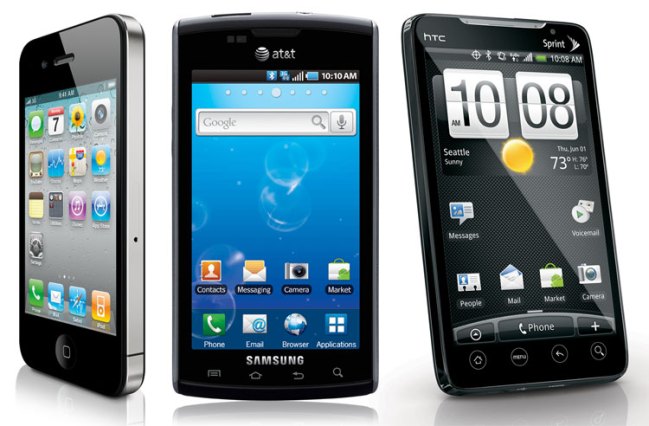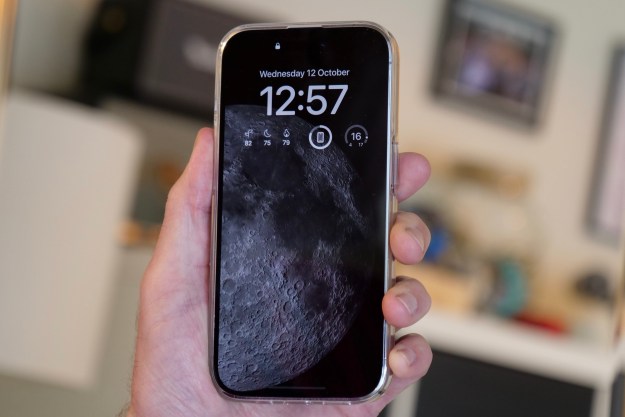
The summer of the smartphone is upon us. With the arrival of a new messiah phone from Cupertino (Apple iPhone 4, $200 on AT&T), the very first 4G phone in the U.S. (HTC Evo 4G, $200 on Sprint), and the fastest Android device on the market (Samsung Captivate, $200 on AT&T), smartphone buyers have never faced a better slate of options – or a more confusing one.
While it’s tough to go wrong with any of these Herculean challengers, one must naturally reign supreme. We’ve pitted all three head-to-head in the most important feature categories to see which phone should call your pocket home.
Display
Winner: Apple iPhone 4
The screens on all three phones equate to big, bigger and biggest, with 3.5 inches on the iPhone, 4.0 on the Captivate and 4.3 on the Evo 4G. So how does the smallest one win?
It’s not all about diagonal span. Both the Evo 4G and Samsung Captivate offer fewer pixels (800 x 480) than the iPhone 4, which quadrupled pixels from the original iPhone to an unheard of 960 x 640. The Captivate also uses an OLED screen. While it looks more vibrant inside, it also washes out easily in the sun, and whites swing toward an unnatural blue. While the bigger size of the Evo 4G and Samsung Captivate might be superior for watching movies, we’re evaluating phones, not media players. The iPhone’s outdoor livability and ultra-sharp text – something you’ll be looking at a lot of – make it the most practical of the three.
 Connectivity
Connectivity
Winner: Evo 4G
With both the Captivate and iPhone 4 sharing AT&T’s infamously hobbled 3G network, and the Evo wearing its first-4G-phone-in-America pin, this one’s a no-brainer. Besides the sheer speed, it’s also the only one that can double as a Wi-Fi router to share connectivity with other devices.
For what it’s worth, the second-place winner between the AT&T phones is just as easy to peg. Reception on the iPhone 4 sucks. Despite all the numbers Steve Jobs packed into a PowerPoint presentation to claim there was no problem with the iPhone 4 antenna (while simultaneously announcing a way to rectify the non-problem), the collective complaints of thousands of iPhone 4 users still speaks otherwise. Frequent dropped calls and notoriously poor reception make the iPhone 4 far inferior to the Captivate for making calls.
Rear Camera
Winner: Apple iPhone 4
The 8-megapixel camera on the Evo 4G has more resolution than both the 5-megapixel iPhone 4 and 5-megapixel Captivate, and more manual search controls, too. But that’s only one part of the story. The iPhone 4 takes better pictures than either competitor.
Credit goes to Apple’s backside-illuminated CMOS sensor, which moves the metal traces typically found on top of the chip to the back, blocking less light and improving overall image quality. Subjectively, photos from the iPhone 4 look brighter with richer color. Both Computerworld and Macworld ran the iPhone 4 head to head with the Evo 4G and found it took better shots, and our own real-life testing showed that the iPhone 4 trounced the Captivate on image quality.
 Videoconferencing
Videoconferencing
Winner: iPhone 4
Front-facing cameras still remain a novelty in the smartphone world, but both the iPhone 4 and HTC Evo 4G offer them, while the Captivate owners are left out in the cold. At a technical level, the Evo 4G yet again offers more resolution: 1.3 megapixels to just 0.3 megapixels (VGA resolution) on the iPhone 4. But as we’ve learned from the previous category, that number isn’t everything.
Bandwidth severely limits the resolution you’re actually able to send over your phone when videoconferencing, so the Evo 4G can’t actually make use of all the resolution it has on tap unless it’s shooting video to record. With image quality nearly level, we give credit to the iPhone 4 for Facetime, which lets users initiate calls from iPhone 4 to iPhone 4 using regular phone numbers – no usernames or logging in needed.
Battery Life
Winner: Draw between Apple iPhone 4 and Samsung Captivate
HTC’s Evo 4G immediately gets booted from the running here. The same 4G speeds that give it killer connectivity also kill the battery in a hurry, leaving it first to run out of gas when these three phones hit the road.
Playing it by the numbers doesn’t lead to any clear-cut conclusion between the remaining contenders. Samsung rates the Captivate for five hours and 50 minutes of talk time and 340 hours of standby, while Apple rates the iPhone for seven hours of chatting and 300 hours of standby, making the Captivate the standby champ and iPhone 4 the king of talk time. While we’re inclined to favor talk time over standby, battery life seemed to play out roughly equally on these two in our real-life tests, so we’re calling it a draw.
Portability
Winner: Samsung Captivate
Clearly, the paperweight Evo 4G is a nonstarter here, but finding the winner among the two phones left standing isn’t easy.
At 2.5 inches wide and 0.39 inches thick, the Captivate fills the hand a bit more than the 2.31-inch-wide iPhone (less than the width of #2 pencil), and measures 0.02 inches thicker, too (roughly the same height as five sheets of printer paper stacked up). Fortunately, it’s also 0.22 inches shorter and weighs only 4.5 ounces to the iPhone’s 4.8 ounces. Which is really more important? We would prefer the shorter, lighter phone, especially when the extra flab it puts on in other dimensions is almost too small to measure.
 Speed
Speed
Winner: Draw between Apple iPhone 4 and Samsung Captivate
All three phones have processors running 1GHz, but which one actually gets the job done fastest? If only there was an easy answer.
Here’s the technical nitty gritty: The so-called A4 system-on-a-chip in the iPhone 4 actually uses an Apple-tailored version of the same ARM Cortex A8 found in the Samsung Captivate. In other words, they share the same silicon bloodline. The Evo 4G’s 1GHz Snapdragon chip, while quick, doesn’t quite run in the same pack as the A8-powered phones.
Which one delivers the best real-life performance? It depends what you’re doing. In our Web browser tests, the iPhone 4 toasted the Captivate over the same AT&T 3G connection, but in others, including Wi-Fi tests by PocketNow and TechnoBuffalo, the Captivate won. In other tests between common apps, both phones are hit or miss. For instance, the iPhone seems to open Google Maps faster, while the Captivate seems to open its camera app faster. In practical terms, they’re about as close as two smartphones come. Things to keep in mind: The iPhone 4 still will not display Flash, so websites will naturally load more quickly. And if you happen to be in a 4G zone, the HTC EVO 4G can load web pages in no time either.
Storage
Winner: Samsung Captivate
For $200, both the iPhone 4 and Captivate deliver 16GB of internal storage, while the Evo 4G comes with only 8GB, putting it out of the running right from the start.
The Captivate manages to stretch far beyond the iPhone 4 with the inclusion of a microSD slot. Besides lending flexibility (you can upgrade when you need the space, rather than guessing whether you will when you buy the phone), it’s also cheaper. While it will cost another $100 to get to 32GB of total storage on the iPhone 4, you can nab a 16GB microSD card and put the Captivate on par for under $40. Even better, it can expand up to a total of 48GB by adding a 32GB microSD card, a level of storage the iPhone 4 can’t touch.
Overall Winner: Apple iPhone 4
The Evo 4G made an impressive showing as the very first 4G phone back in June, but as you can see, it doesn’t hold up nearly as well under the microscope in other categories – at least when stacked against the best other smartphones in the world. The real fight here is between the iPhone 4 and Samsung Captivate.
Had Apple’s overly clever antenna design not blown up in its face and rattled the foundation of the company’s glitch-free reputation, the iPhone 4 would be a standout winner between the two. Instead, the Captivate’s larger storage capacity, gorgeous OLED screen, rock-solid connectivity and relative parity on many other fronts bring it as close to toppling the Cupertino giant as any Android device has likely ever come. But not quite enough to call it an iPhone killer.

Check out our full reviews of the Apple iPhone 4, Samsung Captivate, and HTC Evo 4G.
Also take a look at our other smartphone comparisons:
Motorola Droid vs. HTC Incredible
Editors' Recommendations
- Best refurbished iPhone deals: Get an iPhone 14 for $513
- Best iPhone deals: Save on iPhone 15, iPhone 15 Pro Max and more
- iPhone 16: news, rumored price, release date, and more
- iPhone SE 4: news, rumored price, release date, and more
- Here’s how Apple could change your iPhone forever





